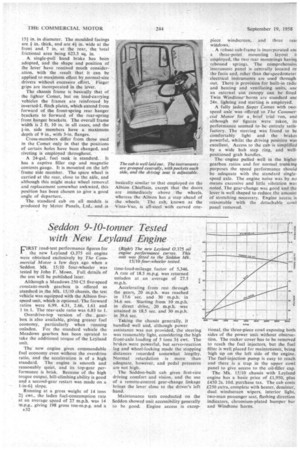Seddon 9-10-tonner. Tested with New Leyland Engine
Page 122

If you've noticed an error in this article please click here to report it so we can fix it.
FIRST road-test performance figures for the new Leyland 0.375 oil engine were obtained exclusively by. The Commercial Motor a few days ago when a Seddon Mk. 15/10 four-wheeler was tested by John F. Moon. Full. details of the test will be published later.
Although a Meadows 250 C5 five-speed constant-mesh gearbox is offered as standard in the Mk. 15/10 chassis, the test vehicle was equipped with the Albion fivespeed unit, which is optional. The forward ratios were 6.99. 4.31, 2.66, 1.61 and 1 to 1. The rear-axle ratio was 6.83 to I.
Overdrive-top version of the_ gearbox is also available, giving greater fuel economy, particularly when running unladen. For the standard vehicle the Meadows gearbox has been uprated to take the additional torque of the Leyland unit.
The new engine gives commendable fuel economy even without the overdrive ratio, and the acceleration is of a high standard. The engine is smooth and reasonably quiet, and its top-gear performance is brisk. Because of the high torque output, hill-climbing ability is good and a second-gear restart was made on a 1-in-64 slope.
Running at a gross weight of 14 tons 24 cwt.. the laden fuel-consumption rate at an average speed of 27 m.p.h. was 14 !m.p.g., giving 198 gross ton-m.p.g and a a32 time-load-mileage factor of 5,346. A rate of 18.5 mpg. was returned unladen at an average of 27.5 m.p.h.
Accelerating from rest through the gears, .20 m.p.h. was reached in . 15.6 sec. and 30 m.p.h. in 34.6 sec. Starting from' 10 m.p.h. in direct drive, 20 m.p.h. was attained in 18.5 sec. and 30 m.p.h. in 39.6 sec.
• Taking the chassis generally, it handled well and, although power assistance was not provided, the steering was reasonably light, considering the high front-axle loading of 5 tons 3+ cwt. The brakes were powerful, but servo-reaction lag and wheel-locking made the stopping distances recorded somewhat lengthy. Normal retardation is more than adequate, however, and pedal pressures are not high.
The Seddon-built -cab gives first-rate driving comfort and vision, and the use of a remote-control gear-change linkage brings the lever close to the driver's left hand.
Maintenance tests conducted on the Seddon showed unit accessibility generally to be good. Engine access is excep
tional, the three-piece cowl exposing both sides of the power unit without obstruction. The rocker cover has to be removed to reach the fuel injectors, but the fuel filter is well placed for maintenance, being high up on the left side of the engine. The fuel-injection pump is easy to reach and there is a trap in the upper cowl panel to give access to the oil-filler cap.
The Mk. 15/10 chassis with Leyland engine has a basic price of £1,950, plus £450 2s. 10d. purchase tax. The cab costs £250 extra, complete with heater, demister, dual windscreen wipers, interior light, two-man passenger seat, flashing direction indicators, chromium-plated bumper har and Windtone horns.
















































































































































































































